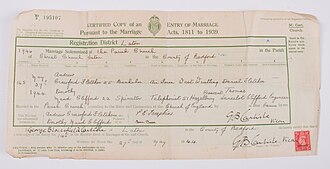
A Marriage return is a proof that a wedding occurred. Marriage returns are one type of marriage record that might be available depending on an ancestor’s location and time period.[1]
A marriage return is the information returned to a town or county clerk by the person who conducted the wedding. This information may have been verbal and recorded on a register or via a document such as a marriage license, bond, or even a scrap of paper filed by a clerk.[2] Unlike a marriage license, bond, or bann, which documents the couple’s intent to marry, a marriage return is proof the wedding occurred.
Genealogy information found on a marriage returnGenealogy information found on a marriage return
Marriage records is a generic term that refers to various records created when a couple intends to marry and then when they actually have a wedding ceremony performed. Depending on the location and era, a couple will have multiple records that can include differing information about the couple, their parents, and the marriage ceremony.
A marriage return can include:
- The name of the bride and groom
- Date and place of wedding
- Location of wedding
- Name of officiant
For more recent marriages, starting in the 20th century, it’s not uncommon for marriage to be recorded on a county and state level in the United States. Counties may have had to report marriage to the state so that records may also be found there.
Where marriage returns can be foundWhere marriage returns can be found
Marriage returns might be found as part of a genealogical subscription website marriage database collection. Marriage returns might also be located in a town or county clerk’s records or their archive.
As you research your ancestors’ marriage records, learn more about the location of the wedding and what records were kept for that time and place. Depending on the place, marriage records may have been kept on a town or county level. Be aware that not all records may be extant (still in existence) or may be found in various places including a local archive or government record office.
Issues with marriage returnsIssues with marriage returns
One of the problems with marriage returns is that although a marriage ceremony occurred the return might not exist. It is possible that the officiant did not return the marriage information to the appropriate government office. Those who officiated at marriages in rural areas were often reluctant to travel the distances required to comply with the law. Sometimes, also, ministers’ records were lost or destroyed before the marriages were properly reported. Itinerant preachers, who crossed jurisdictional boundaries, rarely registered marriages at all.”[2]
Researching the officiant and any personal papers or journals he left behind, perhaps found in a church archive, might be necessary in verifying the marriage. It’s also possible that the marriage return was recorded with a clerk where the minister lived instead of the location where the wedding took place.
Be aware that because the information may have been transcribed by a clerk from documentation provided by the officiant, transcription errors can occur.
See alsoSee also
Explore more about marriage returnsExplore more about marriage returns
- Quebec Marriage Returns, 1926-1997 record collection at MyHeritage
References
- ↑ A Marriage Record Is a Marriage Record Is a Marriage Record—Not!
- ↑ 2.0 2.1 "Vital Records" by Johni Cerny in Szucs, Loretto Dennis and Luebking Sandra Hargreaves. The Source. A Guidebook to American Genealogy.Third Edition. (2006). pg 608.


